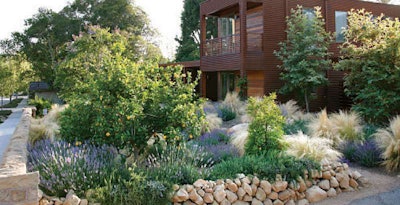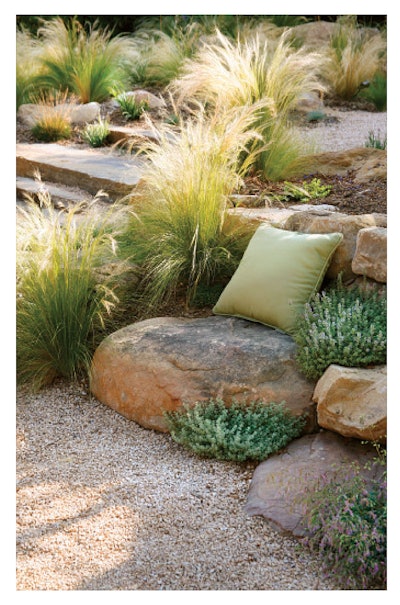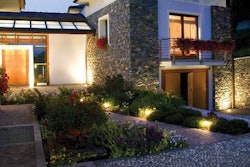 Mexican Feather Grass is a key component of this low-maintenance yard in Santa Barbara, California, which also features smaller grasses like Mueller’s Fescue and Autumn Moor Grass.
Mexican Feather Grass is a key component of this low-maintenance yard in Santa Barbara, California, which also features smaller grasses like Mueller’s Fescue and Autumn Moor Grass.Dramatic, hardy and easy to maintain, ornamental grasses are showing up in new ways in the designs of landscape professionals. There’s a bumper crop of new varieties from which to choose, and they’re no longer being exiled to garden borders and corners.
“If I had to choose only one type of plant for a garden, I would choose ornamental grasses. There are so many different varieties, colors and sizes,” says Chad Beidel, owner of Outside Solutions in Sykesville, Maryland. “Plus, deer won’t eat them.”
One of his favorites is Japanese Blood Grass, which multiplies on its own. Its red-tipped foliage provides great contrast to dark green shrubs like holly and cherry laurel, he says. He also likes Pink Muhly Grass, which has feathery pink plumes that bloom in the fall and last well into the winter.
Favorite Uses
The flow and movement of ornamental grasses create nice contrast to formal plants such as shaped and pruned boxwoods, says William Dickerson, owner of Dickerson Landscapes in Tallahassee, Florida. He also uses them on the edges of beds made up of perennial, flowering plants.
Because they are inexpensive and grow quickly, Scott Price, owner of Snowknows in Charlottesville, Virginia, uses ornamental grasses as temporary placeholders to fill in gaps while an immature garden takes shape. But he also uses them prominently in permanent plantings where he prefers their graceful and arching shapes to straight plantings.
“Their blooms are the icing on the cake,” Price says. “I would use them even if they didn’t bloom, but the late-season bloom they provide extends the season in our spring-bloom dominated area.

His favorite varieties include Variegated Miscanthus, Morning Light, Adagio, Japanese Silver Grass, Switch Grass and Fountain Grass. “It seems every few weeks, our buyer is bringing new varieties for us to try,” Price says.
Ornamental grasses provide height, anchor edges of annual flower beds and serve as erosion controls on large embankments, says Wes Richards of Turftenders Landscape Services, Raleigh, North Carolina.
“They serve many roles in the landscape,” Richards says. “Larger, darker species can function as a back drop to perennial gardens or as a border between spaces, while smaller cultivars can be planted in front of foundation plantings to contrast texture and color from the plants behind them.
“They also make good container fillers for commercial and residential properties, in medians, island beds and landscape boxes.”
Easy Care
Because many species of ornamental grasses are native to North American, they’re drought tolerant, thrive in poor soils and grow where other plants will not survive. And they often require less water and chemical applications. Grasses usually need only a pruning back of the prior year foliage, typically in early spring.
“The larger, more aggressive grasses benefit from an every third year splitting, removing roughly half of the plant mass. This eliminates overcrowding in the bed,” says Jeff Gibson, landscape business manager of Ball Horticultural Company.
Cutting back in the spring rather than the fall will protect the heart of the plant from winter frost and freeze, Dickerson says. He also suggests keeping the crown of the plant arid and open to avoid crown rot.
Price likes working with ornamental grasses so much that he endorses them on his list of “all-star” plants that he recommends to even the most inexperienced of gardeners, confident that the grasses will thrive. “The grasses are easy to maintain and require minimal pruning, fertilization or watering. We use them often in our commercial projects to reduce maintenance costs.”
All-Star Ornamental Grasses
Pampas Grass
Botanical Name:
Cortaderia selloana
Hardiness Degree: 0°F
Plant Habit: Upright
Spacing: 36-48 inches
Height: 60-80 inches
Exposure: Sun
This dramatic ornamental grass displays huge, feathery white plumes from August to October over arching, green foliage. Makes a good winter-interest choice in the landscape.
Fountain Grass
Botanical Name:
Pennisetum setaceum
Hardiness Degree: 32°F
Plant Habit: Upright
Spacing: 24-28 inches
Height: 48-72 inches
Exposure: Sun
The green, upright clump of fountain grass produces tall feathery pink flowers. Tolerant of dry conditions.
Dwarf Purple Fountain Grass
Botanical Name: Pennisetum
Hardiness Degree: 20°F
Plant Habit: Upright
Spacing: 12-20 inches
Height: 18-30 inches
Exposure: Sun
Its small size and vibrant colors make the Dwarf Purple Fountain Grass a perfect choice for containers and small borders.
Ruby Grass
Botanical Name:
Melinis nerviglumis
Hardiness Degree: 10°F
Plant Habit: Spreading, Upright
Spacing: 9-12 inches
Height: 14-18 inches.
Exposure: Sun
This blue-green grass matures to purple-red in fall. Produces silky pink flowers in early summer that turn creamy white in August. Can be used for fresh/dried cut flowers.
Giant Umbrella Plant
Botanical Name: Cyperus
Hardiness Degree: 25°F
Plant Habit: Upright
Spacing: 24-48 inches
Height: 120-180 inches
Exposure: Part sun to sun
Graceful arching stalks are topped by huge hair-like umbrella on this towering plant. Use them in water gardens, landscapes and beds. They must constantly remain wet. If you use them in a container, plug the holes in the pot to keep water in.
Mexican Feather Grass
Botanical Name: Nasalla
Hardiness Degree: 5°F
Plant Habit: Upright
Spacing: 20-24 inches
Height: 12-18 inches
Exposure: Part sun to sun
With its green foliage and feathery tan flowers, this grass will beautify your garden all season and moves in the slightest breeze.
Blue Fescue
Botanical Name:
Festuca cinerea
Hardiness Degree: -20°F
Plant Habit: Upright
Spacing: 6-9 inches
Height: 12-16 inches
Exposure: Sun
Festina Blue Fescue is a blue-green color. Its dense, compact tufts have small, upright brown plumes summer to fall.
Juncus
Botanical Name:
Juncus pallidus
Hardiness Degree: 10°F
Plant Habit: Upright
Spacing: 18-22 inches
Height: 48 inches
Exposure: Sun
An excellent thriller for mixed containers.
This tall green grass makes a dramatic statement and can grow in standing water. The grass also handles heat and drought.











